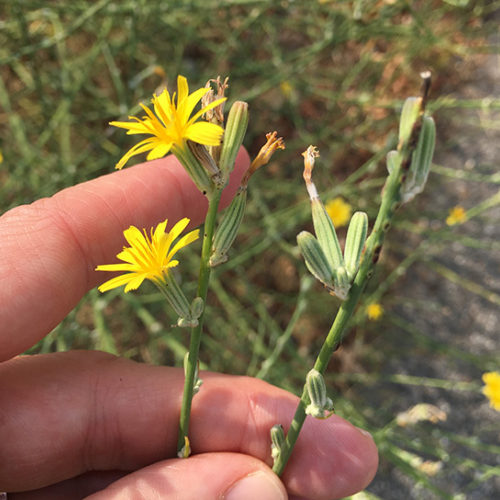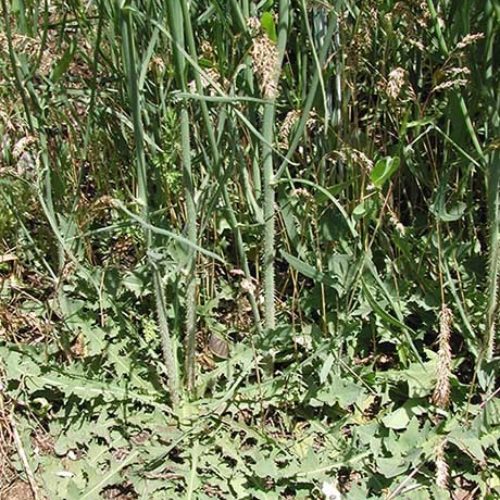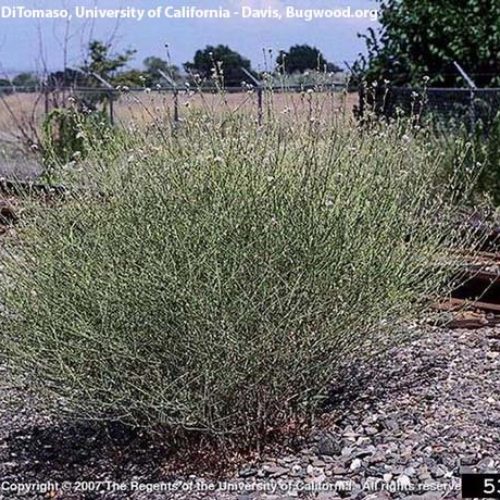Rush Skeletonweed
Chondrilla juncea

Family: Asteraceae
Weed class: B
Year Listed: 1988
Native to: Europe, Asia and Northern Africa
Is this Weed Toxic?:
not known to be
Why Is It a Noxious Weed?
Rush skeletonweed is a threat to irrigated lands, wheat areas and rangelands. Rangeland infestations displace native and beneficial forage species grazed by livestock and wildlife.
How would I identify it?
General Description
It is a perennial ranging in size from 1 to 5 feet tall. Its long slender taproot can grow up to 7 feet deep. Plants begin as a basal rosette of leaves and then grow 1 to 6 branching flowering stems. Plants will exude a latex sap from injured surfaces.
Flower Description
Flowerheads 1/2 inch in diameter and grow in leaf axils and stem tips, single or in clusters. Flowerheads have usually 11 (7 – 15) yellow ray flowers. Green bracts at base of flower head in a single row followed by a single row of smaller bracts.
Leaf description
Basal leaves are lobed with lobes pointing back towards the leaf base. Leaves on branching stems are few, narrow and may have entire (smooth) edges.
Stem description
Stem bases have coarse, downward pointing brown hairs and are hairless toward the tips. Stems are highly branched and have few leaves.
Fruit Seed Description
Seeds 0.1 inch (3 mm) with ribbed surface and white bristles (pappus) on one end that aid with wind dispersal.
Where does it grow?
Rush skeletonweed is found in pastures, rangeland, cropland, roadsides, open and disturbed areas. Please click here to see a county level distribution map of rush skeletonweed in Washington.
How Does it Reproduce?
Plants spread by seed with each mature plant producing between 1,500 and 20,000 seeds. Rush skeletonweed also spreads by shoot buds found along lateral roots and from shoot buds found near the top of the main root. It also grows from root fragments in the soil.
How Do I Control It?
General Control Strategy
Research found that an integrated approach, using both plant competition and biological control agents, often results in better control then either method used separately. Herbicide control may vary depending on the biotype of rush skeletonweed.
Mechanical Control
Hand-pulling can work for small infestations. Areas must be controlled 2 to 3 times per year for 6 to 10 years to remove seedlings and re-sprouting roots. Removal of deep tap roots is easiest when soils are damp. Mowing plants repeatedly may reduce plants' biomass and seed production but may not provide eradication.
Cultural Control
Using beneficial forage species for competition will not suppress the dominance of rush skeletonweed. Continual grazing decreases populations while rotated grazing increases populations.
Biological Control
The rush skeletonweed gall midge (Cystiphora schmidti), the rush skeletonweed gall mite (Eriophyes chondrillae), and the rush skeletonweed rust fungus (Puccinia chondrillina) are biological control agents used in Washington. Contact the WSU Integrated Weed Control Project for more information.
Herbicide Control
Please refer to the PNW Weed Management Handbook, or contact your county noxious weed coordinator.
For More Information
See our Written Findings for more information about rush skeletonweed (Chondrilla juncea).
UW Burke Herbarium image database information on Chondrilla juncea
Thurston County NWCB Fact Sheet on rush skeletonweed
Franklin County NWCB Fact Sheet on rush skeletonweed
Asotin County NWCB Fact Sheet on rush skeletonweed
Pierce County NWCB Fact Sheet on rush skeletonweed
Stevens County NWCB Fact Sheet on rush skeletonweed
Control Options for rush skeletonweed from Lincoln County NWCB



















